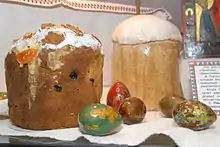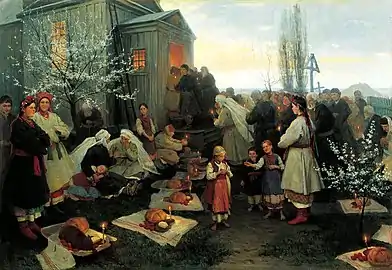Paska (bread)
Paska (Ukrainian: пáска, romanized: páska, literally: "Easter", Georgian: პასკა, romanized: paska, literally: "Easter", ultimately from Aramaic: פסחא, romanized: ?, literally: "Passover")[1] is a Ukrainian[2][3][4][5] Easter bread tradition and particularly spread in countries with predominant Eastern Orthodox religious or cultural connections to the ancient Byzantine Empire.[6] Paska breads are a traditional element in the Easter holidays of Ukraine, Armenia, Belarus, Romania, Russia, Georgia, Moldova and parts of Bulgaria, as well as Turkey, Iran and the Assyrian–Chaldean–Syriac diaspora. Due to its geographical closeness, it is also widespread in Slovakia. Meanwhile it is also eaten in countries with immigrant populations from Eastern Europe such as the United States, Canada and the United Kingdom.
 | |
| Type | Sweet bread |
|---|---|
| Place of origin | European / Eurasian countries with predominant Orthodox religion |
| Main ingredients | Milk, butter, eggs, sugar |
Etymology and origins
Easter is called in the Ukrainian language па́ска (páska) whilst in Russian it is spelt па́сха (páskha).[7] The Ukrainian word па́ска (páska) is traditionally used to describe the easter bread in Ukraine whilst Вели́кдень (Velýkden) is used to denote the day.[8][9] Whilst Russia has its own easter bread called кули́ч (kulích) and the word па́сха (páskha) is used to denote the day. The word is connected to Ancient Greek word πάσκα (páska) and Georgian: პასკა (paska, "Easter"), derived from the Orthodox believers in Byzantine Empire. The name is connected to the Jewish holiday of Pesach.[10]
In Finland the name Pääsiäisleipä ("Easter bread") is used, because paska is an obscenity in Finnish meaning "shit".
Christian symbolism

The Christian faithful in many Eastern Christian countries eat this bread during Easter. Christian symbolism is associated with features of paska type breads. The inside of paska can be a swirl of yellow and white that is said to represent the resurrection of Jesus while the white represents the Holy Spirit. Other versions include chocolate, rice, or even savoury mixtures based on cheese. A version is made with maraschino cherries added to symbolize royal jewels in honor of the resurrection of Jesus.[11]
Traditional ingredients

Paska is made with milk, butter, eggs, flour, and sugar, except for the Romanian pască where the recipe most commonly includes sweet cream, cottage cheese, and/or sour cream along with eggs, sugar, raisins, and rum. An egg and water mixture is used as a glaze.
Ukraine

In Ukraine[12][13] it is tradition to fill your Easter basket (koshyk) with Easter eggs (pysanky), Easter bread (paska), sausage (kovbasa), butter, salt and other ceremonial foods on Holy Saturday (Easter Eve). On Easter morning, after the liturgy and the blessing of the paska and other staples, everyone returns home to feast on the eggs, cold meats, and other goods that were blessed at church.[14] After the matins all the people in the congregation exchange Easter greetings, give each other krashanky, and then hurry home with their baskets of blessed food (sviachene). In eastern Ukraine they go home, place the sviachene on the table, and the oldest member of the family opens the cloths in which the food is wrapped, slices pieces from each item, and distributes them to members of the family along with a piece of unleavened bread that has also been blessed. In Western Ukraine, especially in the Hutsul region, the people first walk around the house three times, go to the stable, extend Easter greetings to the cattle, touch them with the sviachene, scatter pieces of Easter bread and salt in the manger, and send holiday greetings to the bees. Only then do they enter the house, ceremoniously open the bundle (dorinnyk) over the heads of the children, and sit down to the table to break their fast.[15] Modern pasky usually have a white glaze made from sugar and egg and are decorated on top with coloured wheat grains or poppy seeds. However, an old custom, which is still practised in some Ukrainian regions and diasporas, is to create dough ornaments for the paska. The symbolism of these ornaments is connected with spring themes: the awakening of nature, resurrection and rebirth. Birds, especially larks, as heralds of spring, took a much-deserved place on pasky.[16]
Assyrian paska
In Iran and the diaspora, Assyrians will eat a paska cake on Easter, Ida Gura. The tall cake is decorated with a cross on top to represent Calvary, the place of Jesus' crucifixion, and surrounded with colored eggs to symbolize the people who visited Jesus during his death and were at his cross.[17]
Eaten with other foods
Paska is eaten with hrudka, also called syrek, a bland sweet custard similar to cheese made from separated eggs and milk and beets mixed with horseradish (chren/hrin) and kielbasa (in Polish) or kovbasa (in Ukrainian).
Pască
 Pască with cheese | |
| Type | Pastry |
|---|---|
| Place of origin | Romania, Moldova |
| Main ingredients | eggs, sour cream, fresh cheese, raisins, sugar |
Pască is a traditional Romanian and Moldovan pastry.[18] Especially made for Easter, pască is a tart with a cozonac dough base filled with fresh cheese like urdă or cottage cheese, raisins, eggs and sugar. Other variants include sour cream, chocolate, or berries fillings.[19] The word Pască come from Latin, Pascha, meaning "Easter".
See also
References
- "Артос: пасхальный хлеб". Православный журнал "Фома". 2018-04-14. Retrieved 2019-02-25.
- Hudgins, Sharon, author. (15 May 2018). T-bone whacks and caviar snacks : cooking with two Texans in Siberia and the Russian Far East. ISBN 978-1-57441-722-7. OCLC 1035845794.
For Russians, paskha is also the name of a special cheese desert made only for Easter, always accompanied by the Russian Easter bread kulich. For Ukrainians, however, Paska is the name of their own Easter Bread, a wide, round, yeast-raised, sweet bread decorated with white icing
CS1 maint: multiple names: authors list (link) - "Ukrainian Easter Bread". Martha Stewart. Retrieved 2020-05-24.
- "Traditional Easter Recipes: Paska (Ukraine)". www.tasteatlas.com. Retrieved 2020-05-24.
- "paska | Ukrainian recipes". Ukrainian recipes - for a tasty life. Retrieved 2020-05-24.
- Delfavero, Gina. "Orthodox traditions observed locally for Easter season". TribLIVE.com. Retrieved 2018-11-19.
- Hudgins, Sharon (15 May 2018). T-Bone Whacks and Caviar Snacks: Cooking with Two Texans in Siberia. p. 256. ISBN 9781574417227.
- "Encyclopedia of Ukraine".
- "Paska or Paskha or Velykden (Snidanok)".
- Braun, Connie (2017). Silentium: and other reflections on memory, sorrow, place, and the sacred. Janzen, Jean. Eugene, Oregon: Resource Publications. p. 158. ISBN 9781532617928. OCLC 1020497898.
- Joan Halmo Celebrating the church year with young children Liturgical Press, 1988 ISBN 978-0-8146-1580-5. 159 pages. page 43
- Hudgins, Sharon (2018-05-15). T-Bone Whacks and Caviar Snacks: Cooking with Two Texans in Siberia and the Russian Far East. University of North Texas Press. ISBN 9781574417227.
- "Ukrainian Easter Bread". Martha Stewart. 2011-07-25. Retrieved 2019-03-02.
- "Encyclopedia of Ukraine".
- "Encyclopedia of Ukraine (Easter)".
- "Tradition of Paska – Ukrainian Easter Bread".
- Hassanzade Ajiri, Denise (2019-12-04). "A Portrait of an Assyrian Family in Iran". aina.org. Retrieved 2020-04-13.
- definition of pască (in Romanian) dexonline.ro
- 10 recipes for Pască
External links
| Wikimedia Commons has media related to Paska (bread). |
- Paska recipe at the Wayback Machine (archived 28 March 2016)
